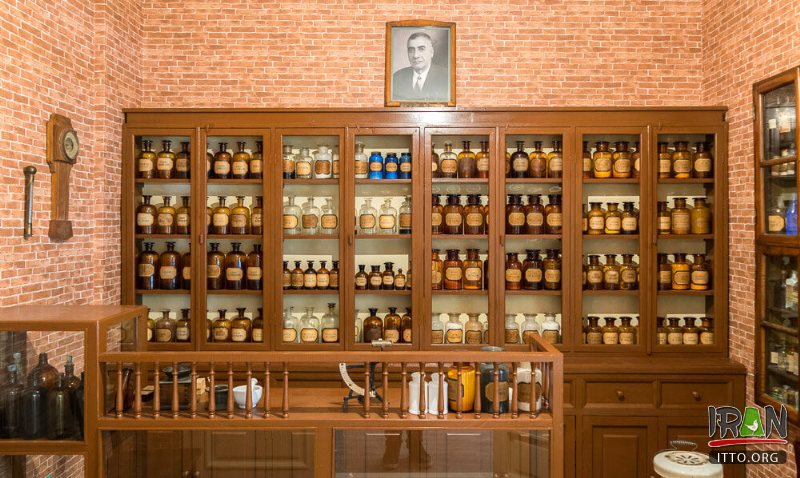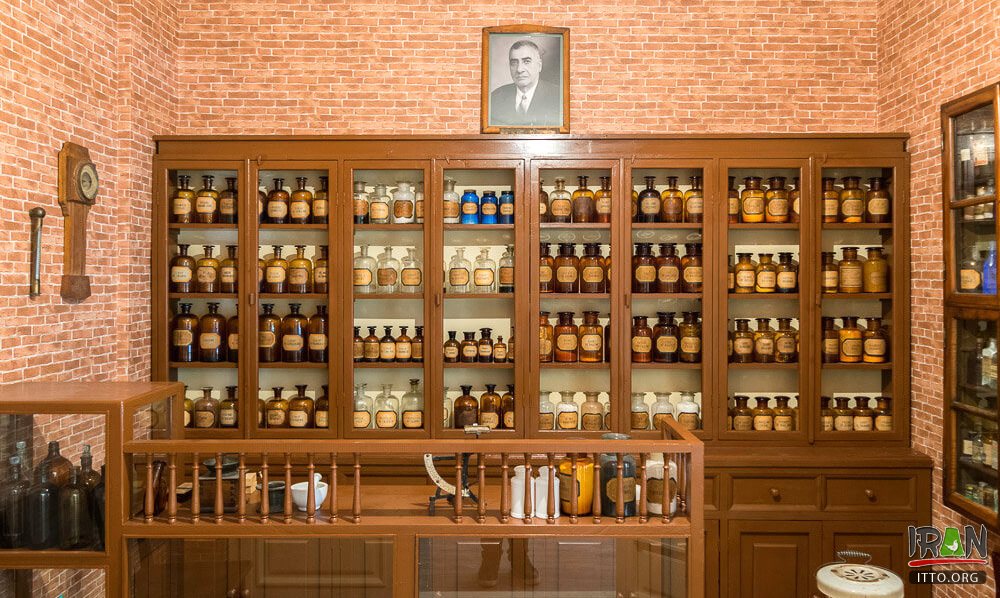The idea of launching a unique museum has been formed in the minds of the Sarabi brothers since 25 years ago. The eyes of the two, in the old houses of the old villages of Azerbaijan, in the historic market of Tabriz, in Gegiel Square, in the crypt of the gardens house, in Anbar, the old shops were looking for objects that show history, a documentary and an old device. The true narrative of the past and the World Cup is the view of the culture, literature and customs of Iranians and people of Azerbaijan.
Old pictures, manuscripts, rusty metals, all were all worthy of the fact that the Sarabi brothers were the buyer of their breast chuck instead of buying a home and a villa and a car. From those books and documents and photographs, the lifestyle, facilities, and devices used in the Old Testament could be made clear. If they were wearing an antique and semi-precious stones, they would look for objects in the context of their previous mindset and studies, the original and actual examples of which were now forgotten in these shops and houses, and thus collecting this The objects also went from the beginning with a specific and pre-designed purpose and program. The goal was to launch the "First Iranian Museum of Occupations" on its forehead in its prospect.
Thus, Reza and Yaqoub established the foundation stone of the first museum of jobs in Tabriz. In the first step, 12 jobs were defined and initial steps were taken to prepare their tools. These occupations were:
Telegraph:
One of the richest and most spectacular parts of this museum is dedicated to the old telegraph equipment. The transmitter and receiver of the telegraph (related to the Nasir al-Din Shah era) and the small power-generating device that was charged with hand are precious and durable objects that the mirage succeeded in making it with great effort and cost, and despite the insistence of some museums And the departments of other cities have not sold it. The telegraphs of 100 years ago, as well as the telegraph paper by Mohammad Nakhjovani (founder of the Tabriz National Library), Gapan (large scale weighing goods), are among the works that can be seen here.
According to Sarabi, old telegraphs both sent telegraphic messages and were responsible for sending postal items, so it is important to explain the facial expression and appearance of the job.
For the manager of the telegraph, the inspiration from the old photographs will be a man who will be seated on a wooden chair, overwhelming the tiny crampons on the desk of the telegraph paper.
Attari:
Although Attari is now an outdated and scarce profession, he was considered one of the most important jobs in the old age. Cartier boxes, foreign canisters, which were commonly found in Qajar times, were discovered and bought from one of the villages of Ahar city.
Grocery & Groceries:
Henna's old bags, yellow sugar candy and the remains of that time, cans of tea are part of the assets of this booth. The virgin bought Henna bags from an old Azerbaijani woman with pleasure and pleasure.
Rose and perfume glasses were also present in the old grocery shops, examples of which are now available.
Stroller and Drapery:
Another kind of work that was very booming in ancient times is a drapery and drapery. Colorful fabrics, eye-catching silvers, red and delicate velvets, beautiful cashmere are all the relics of that era. Arshin was a measure of the size of the fabrics that was purchased from an old fashioned one. Mirabi is trying to satisfy an elderly citizen of Tabriz to sell some of the old cloths in his box to sell this valuable treasure.
Carpentry:
Saws, piles, wood and timber holders, old nails and hammer, are the tools collected by this section.
Forging:
This section includes iron, metal, and alloys and metal melting furnaces, chains, kebades and das. According to Sarabi, so much iron was collected during this period, which weighs over two to three tons. As far as their transfer and handling was very difficult.
Pharmacy:
Today, when you get into a boredom, you get a copy of the prescription to a pharmacy and you will receive your medications, including capsules, pills and ampoules. But it's interesting to know that about 100 years ago, this form of drug was absent. The drugs were mostly in the form of liquids held in brown glass. The glasses that were labeled with each year of the drug and the manufacturer's name.
The pharmacist was blamed on the basis of a copy of the book that he had given these drugs with the compounds mentioned and provided the patient with a new drug.
Medical devices for the first time, medical prescriptions for the year 1298, special medication weighing scales, medical certificate (1306 solarium), medical book formulas of Dr. Toomanian, microscope (dating back to 1874), pharmacy counter and so on, with All tastes are collected and displayed in the Museum of Occupations.
In this section, a collection of old medicine glass from a crypt of a former doctor in Tehran has been purchased.
Antique Sale:
The shops in the Qajar period were the role of casual stores, extras, and ceremonies of today.
Mill:
The large and black grinding stones, along with the old cast iron axes, handled the flour and turned the wheat into flour. What is happening now in big and modern factories. Now samples of these rocks and the flour mill are collected by mirage.
Dyeing:
Still, some Azerbaijani people use the word Boyah, in their proverbs. But Boyah was the central house where she sold dyeing goods and painted them with rugs, Jayim, carpet and fiber.
Some of the main features of this profession include dyed boilers and old paint cans that will be displayed at the museum.
Matha (print shop):
One of the oldest pedaling machines that worked without electricity was brought to Tabriz during the Mozaffaroddin Shah Qajar era. Now, that printing machine has been purchased by Mr. Sarabi for millions of dollars and has been prepared for the Museum of Occupations. Apart from this printing machine, the shelves and boxes of letters of manual lead are also collected.
Binding:
Old instruments like the specialty of this profession, shelling, serie and ... have a special place in this museum as well.
In order to enhance the attractions of the Museum of the Market and the natural beauty of the museum, a sound system related to various businesses in the individual chambers of the museum has been installed, and thus, visitors entering into that chamber, the voice of the work activity there Hijab will be heard and there will be a kind of nostalgic sensation in visitors. In the public road of this market, the natural voice of people in the Tabriz market and the voices of the porters are heard.
This museum is located next to the Tabriz market and is similar to the architecture of this historical market and is being implemented for the first time in the country.
It is worth noting that the Museum of Occupations has been implemented in three floors of a structure, one floor to the Museum of the Market and other classes dedicated to the exhibition of marketplace image paintings and other artistic works.
Reza Sarabi Aghdam says about the works and tools collected:
What was most important to us in this difficult and painful way was the authenticity of each piece of art and work. A museum is worthwhile when the original version of a device is exposed to the public, and if it does not provide a copy of a historical document, it has no historical value or documentation. Therefore, over the past 25 years, we have always focused on the core of the works. We recognize the authenticity of the goods from old photographs and authoritative books. For example, we found the first-wheel drive of a car that entered Iran in the Qajar period (1904) from a historical book. A design that helped us to come up with a perfect fit with the sample. Or, for the revival and implementation of the Mirab Tabriz, the shape of the barrels that were used in the Gazan region of Tabriz was extracted from several old books.
It is interesting to note that the barrels of water supply and distribution in the old city of Tabriz with the water barrels of other Iranian cities were slightly different at that time, and this apparent difference indicates that Tabriz was more industrialized and progressive than other cities of Iran at that time.
In order to establish this museum, an old-fashioned market in Tabriz should be built to accommodate these shops on both sides of the market, in order to model the old Tabriz bazaar and other active businesses in that era, such as those who are on the front Or into the marketplace, we would give this spirit to the market, such as Tizakan Knife, Fatemounchi, Hamal (Kargar) and ... in the old markets of Tabriz will be live and effective.
By announcing the global registration of the traditional Tabriz market on the UNESCO list, once again, the subject of trade and trade in the Old Testament, especially in the traditional bazaar of Tabriz, became the focal point of the news and historical circles. Therefore, there is no doubt that the construction of this complex Loneliness is not worthless, but the vivid and dynamic nature of this collection, the quantity, quality and variety of guilds and the trade in it, has been an important factor in recording this work. In the meantime, addressing the businesses and gurus of this market over the last 100 years can add to the attractiveness of the tourists, and the launch of its business museum will be of great help to this end.
Ya'qub and Reza Sarabi Aghdam, not only in the field of the establishment of the Iranian Museum of Occupations, but also in their creative enthusiasm, are also indescribable enthusiasm. Collection of ancient Iranian lanterns (about 70 lanterns). Layers of water reservoir, lattice windows and old Chinese knot, collections of old weapons and bayonets, collections of postal letters of Iran during the Qajar period, telegraph devices and old phones, writing equipment And the old office, coins, badges and war courage medals, especially World War I, are among other valuable tools that the Sarabi brothers have dedicated to collecting.
The works of art and art sculptures of these two brothers are shown not only in Tabriz but also in most cities of Iran. The statue of Ibn Sina in the cities of Babolsar and Minab, the Qajar girl and old ball in Minab, the stone of the letter of Hippocrates in Tehran, the rural girl in Karaj and statue of Hajj Rasul Sedghiani, a cannon for Tabriz Constitutional and Qajar museums and a statue of a photographer Bashi. The training and sculptures of Colonel Pesian Pilot Pilot Tabrizi in Marand Road are now open to visitors and interested in the history of Iran and Azerbaijan.
The creation of a museum called the Museum of Occupations was added to the first list of the first ones in Tabriz city.



